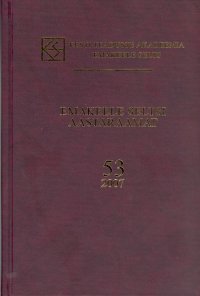Supiinid koha väljendajana: liikumissündmuse keelendamise asümmeetriast
Supine constructions encoding spatial entities: asymmetry in expressing motion event
Author(s): Heili Orav, Renate Pajusalu Subject(s): Language and Literature Studies
Published by: Teaduste Akadeemia Kirjastus
Keywords: syntax; supine; motion event; construction
Summary/Abstract: This paper examines asymmetry in the system and usage of Estonian supine forms. The main objective is to determine the regularities that govern the categorization of spatial characteristics of motion events in Estonian, and to describe how supine constructions are used to encode them. The analysis is based on the data drawn from a morphologically disambiguated corpus, which is compiled at the University of Tartu. In addition to adverbial NPs and pre- and postpositions, there are also in- fi nitival verb forms that function as the counterparts of adverbial NPs in locative cases − the illative form of the supine (söö-ma ‘to eat’), the inessive form of the supine (söö-ma-s ‘to be (somewhere) eating’), and the elative form of the supine (söö-ma-st ‘(come) from eating’). After a short description of the Estonian case system and its categories of motion events, we present our results on asymmetry of GOAL, SOURCE and LOCATION in Estonian. Our data show that GOAL is the most frequent category expressed by adverbial NPs in sentences that describe a motion event. As we expected, the use frequency of the ma-supine encoding GOAL is higher than that of the mast-supine encoding SOURCE and the mas-supine encoding LOCATION. The main result of this paper is, however, that the prevalence of GOAL among supine-encoded categories of motion event is very much stronger than in the case of adverbial NPs. A number of reasons may be given to explain why GOAL tends to be encoded more frequently when expressed by a complex supine (combining location and activity). For instance, this holds when comparing supine-encoded GOALs with NP-encoded ones. In any case, the data show that if GOAL, SOURCE and LOCATION contain time, place and activity at the same time (as is the case with supines), the movement toward the future is more important than when these categories express ‘simple’ location (as is the case usually with NPs).
Journal: Emakeele Seltsi aastaraamat
- Issue Year: 2007
- Issue No: 53
- Page Range: 104-121
- Page Count: 18
- Language: Estonian

